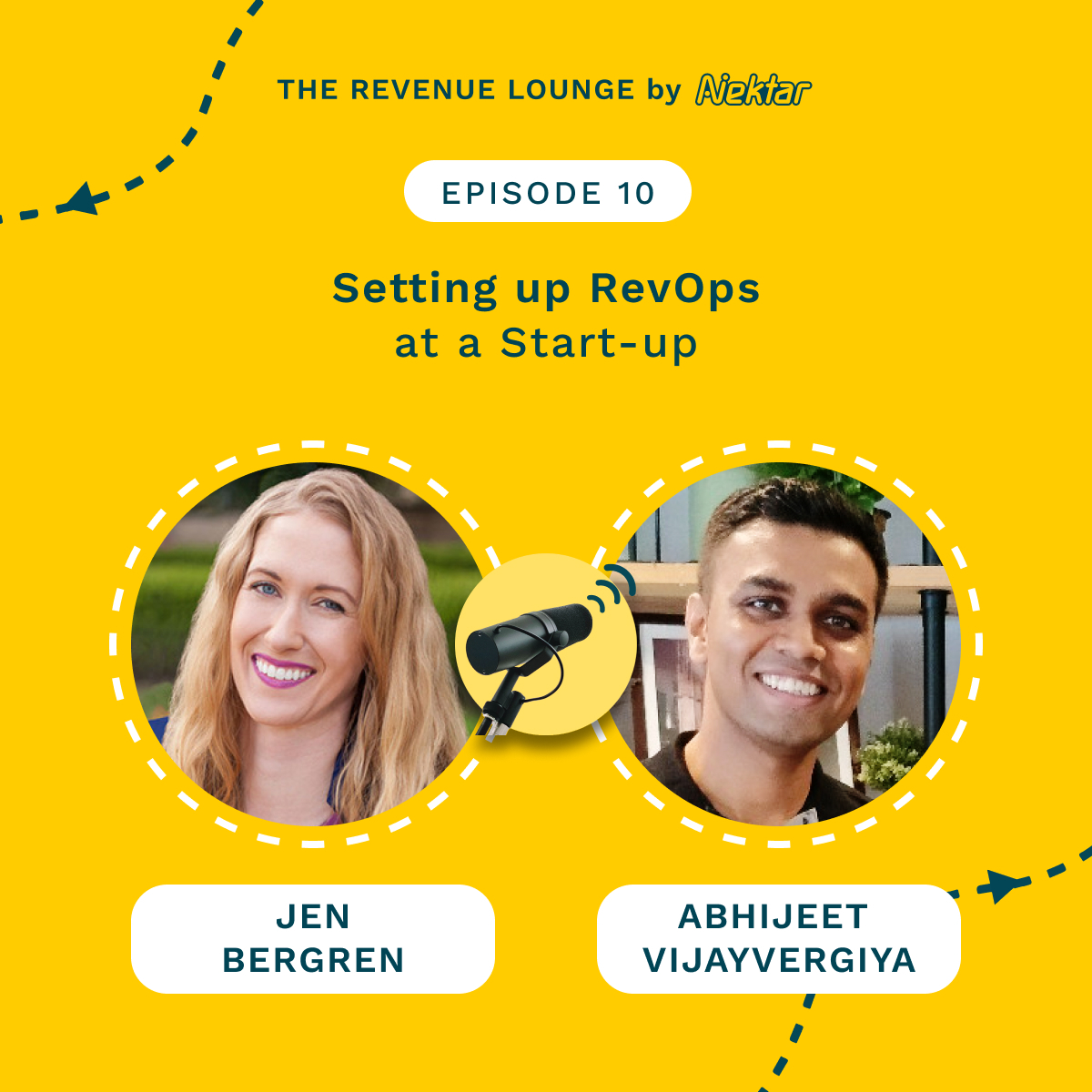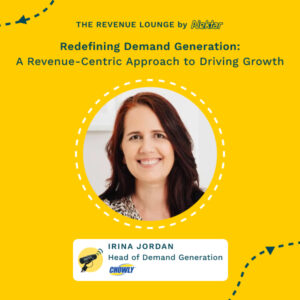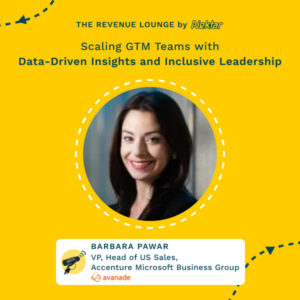Transforming the Customer Journey with Consumption Selling ft. Santosh Sahoo
December 3, 2024
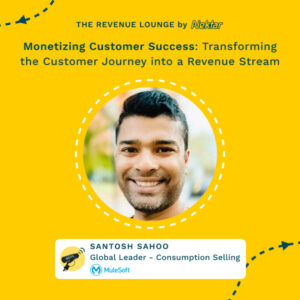
About
The Revenue Lounge
The podcast covers stories from leaders across RevOps, Sales, Customer Success, GTM, Data and Marketing about what drives these functions and what advice they would share with our listeners. With 3 seasons recorded, the podcast currently features 50+ enterprise leaders in the B2B SaaS domain. Tune in to hear from the best in the business
- Customer success is now a pivotal component of revenue generation.
- Consumption-based pricing models are becoming the industry standard.
- Transparency in usage and pricing enhances customer trust.
- Sales teams must adapt to a continuous engagement model.
- Customer success managers need to understand domain-specific challenges.
- Tiered success packages can drive customer satisfaction and retention.
- The shift to consumption models requires significant change management.
- Customers are interested in consumption models but wary of costs.
- Value delivery must be aligned with customer usage patterns.
- The future of SaaS will likely be consumption-oriented rather than seat-based. Understanding the customer journey is crucial for sales success.
- Measuring consumption metrics is essential for growth.
- Executive sponsorship is vital for implementing new pricing models.
- Transparency in pricing builds trust with customers.
- Defining roles and teams for consumption models is key.
- Data rigor is necessary for effective customer success management.
- Sales pipeline management principles can be applied to post-sales.
- The future of pricing models will see broader adoption of consumption-based strategies.
- Customer feedback plays a significant role in shaping pricing models.
- The reception of new pricing models has been surprisingly positive.

Randy Likas (00:02.432)
As businesses increasingly shift towards consumption-based pricing models, the role of customer success has evolved into a pivotal component of not only keeping customers engaged, but also unlocking new revenue opportunities. Monetizing customer success has become a key strategy, turning the customer journey into a new revenue stream through productized offerings, tiered success plans, and proactive value delivery. Hello, everyone. Welcome to the Revenue Lounge Podcast. I’m your host, Randy Likus.
And in this episode, we will dive into what it takes to transform customer success into a powerful revenue engine. We’ll unpack strategies and best practices to help monetize your customer success efforts and maximize the value you deliver to your customers. And joining me today is Santosh Sahoo. Santosh is the global leader of consumption selling at MuleSoft. He has over 20 years experience in sales, customer success, professional services, and engineering. Before stepping into his new role,
He was leading global customer success teams from ULsoft’s automation and retail and consumer goods operating units. Tash, thank you so much for joining us today.
Santosh Sahoo, MuleSoft (01:04.851)
Thanks, Randy, and thanks for that introduction. Very excited to talk to you about this.
Randy Likas (01:09.112)
I am as well. As you and I talked in the green room, this is a topic as we talk with leaders across go-to-market. It’s something I think a lot of companies, if they haven’t moved there, they’re considering it. And so I’m really excited for what you have to share with us today. So I’d love to start these episodes and just to have you maybe give us a little bit of background on your background and then sort of what your current role is at MuleSoft.
Santosh Sahoo, MuleSoft (01:37.748)
Sure, my background as you mentioned, started with engineering for last 20 years. Everything that I have done is predominantly in technology and very much like the CIO, CTO, that landscape of technology space. But within that, I have played all kinds of roles starting with like backend engineer coding for seven years to, you know, be a field sales representative for a couple of years, being an account manager, owning P &L and then customer success for last seven years within MuleSoft.
So both back and front end and lot of field roles. Within that, for last seven years before my current role, I was in customer success in MuleSoft, driving the four key pillars, which is adoption, retention, expansion, and advocacy efforts within MuleSoft. We recently formed this new team, which is a consumption selling team within MuleSoft. And I joined to lead that for this is like the third month in the role.
very, very net new for MuleSoft, net new for the company. And this is more aligned to where the industry is going, right? More products increasingly are consumption oriented products, especially with AI that you see every net new AI product as a consumption oriented product, right? So that’s where my efforts are focused on. So yeah, that’s a brief journey.
Randy Likas (02:56.034)
Great. So what led to the decision to shift the company’s service model to being more consumption based?
Santosh Sahoo, MuleSoft (03:03.156)
I think it’s where the industry is going to go, right? I think if you look at SaaS, Salesforce was a pioneer in SaaS. Like the SaaS term is tied to Salesforce, right? And then the original model was the seat-based licensing model, which still continues to be the most popular model with typical SaaS companies, right? Then came the whole wave of infrastructure companies, and I AWS probably pioneered the whole world around consumption, right, with compute.
but then compute database, infrastructure integration all started going more consumption based, right? And what’s happening with the third wave is like we have the whole wave of AI and applications built on top of AI. And this is where truly both customer expectation and the company’s delivering solutions, they wanted consumption based. So if you think of an agent or a query or anything, everything is priced based on that single transaction.
So the customer does the transaction, gets immediate value and they’re paying for it. Versus in a seat based philosophy, there is a promise and then you have bought based on the promise. You might get the full value, might not. Sometimes there is the concept of shelf where and things like that. But I think we are all heading towards a true utility based model if you call it right. And that’s where I think in our Salesforce, we continuously redefined ourselves. So this is the whole.
in a process of redefining and we are not unique in that. think every large enterprise is thinking through how they gear towards a consumption oriented company.
Randy Likas (04:32.322)
So will seat-based pricing go away completely, or will SEL’s, know, SEL a license, and then the service component on top of that is consumption-based? Which kind of model is it gonna follow?
Santosh Sahoo, MuleSoft (04:43.75)
Yeah, I mean, I think what will happen is as organizations introduce new offering, especially tied to their AI related products, right? Those will start more looking like consumption oriented while they will still continue their core businesses, which is either seat based or compute based or whatever. But what happens is I think this is where most of the industry is looking at is in future, these AI oriented applications will replace your standard.
SaaS applications like 20 years down the line SaaS won’t be SaaS right it will be a fundamentally different world so then this net new model would have taken roots as as the go-forward model I think we are in the phase where there will be hybrid phase of your core business in a particular pricing model and net new that you introduce would be on a you consumption based or transaction based model right that’s kind of the hybrid phase we are
Randy Likas (05:15.585)
Yeah. Yeah.
Randy Likas (05:34.946)
Now, what’s been kind of the biggest challenge in moving this model both internally and externally? So I would imagine there’s probably a big change with how reps are comped, how CSMs are comped. There’s got to be different sales and CS enablement that you need to go through. The alignment and the change management involved in that.
All of those things. then, so that’s, guess, what I consider the internal side. And then there’s the external side, which is when you have this conversation with customers. So what does that look like for you?
Santosh Sahoo, MuleSoft (06:07.904)
Yeah, yeah, I think what I can give you a more view from a industry perspective, because I think there are infrastructure centering companies who have a way head start in this, right? And I think I can give you the perspective. We are figuring it out, a of other things, right? So from that perspective, the answer is nuanced. It’s a very, very net new motion. So let’s think of internal perspective, right? Typically, if you want to…
go to a consumption based model, you have to figure out how does your product look like a consumption oriented product, right? You to begin with, right? Then your pricing strategy has to align with it, right? Like how do you price the product? Like a transaction based, query based, answer based, whatever it is, right? And then you have to figure out the whole go-to-market model to go with it, right? So, how do you incentivize AEs, SCs, post sales motion, right? And how does that flywheel work?
to drive consumption and then drive expansion, right? So those are like the three components and three go hand in hand. In all of that, there is a big part which is like the transparency to the customer around value, right? So imagine like if you look at AWS as an example, right? Like every customer, whatever they use, they very transparently can go and see in a dashboard exactly how much they’re using and what they’re paying for. Like I in fact take a step back, like if you have a…
electricity provider, you can log into the portal and see exactly how much electricity you used, how much gas you used, how much you paid for it, right? So the level of transparency of tying value to your usage is a big component in gearing towards it, right? And this is where you building the tooling inside and exposing that to customer to be able to visualize. So from our perspective, we are working on all of this, right? We’re working on figuring it out what the product is gonna look like.
How is our pricing methodology gonna look like? How is our go-to-market motion is gonna look like? And then change management in each of that places, And then there is the whole customer education side of it, right? Like, taking that script and then getting customers onboard with this new model. What we have seen is naturally customers are extremely interested in getting onboard. What they wanna figure out is, does the value go in proportion with cost, right?
Santosh Sahoo, MuleSoft (08:31.98)
because you would have seen innumerable articles about like, my AWS cost is my biggest line item in my whole PNL, right? It’s consumption based, but what happens is once you get used to it, you see value and you start keeping consuming. So what your CFO needs to know is, great, new model, do I end up exceeding even more than my current spend, right? So there is that change management piece from customer’s perspective.
Randy Likas (08:56.696)
Yeah.
Santosh Sahoo, MuleSoft (09:00.084)
So yeah, we are working on all of that for, we are very, very early in the innings if you look at like as an entire org. And I think most orgs are in that phase, right? I think pure play infrastructure organizations like, know, AWS or MongoDB or Snowflake, I think they are slightly ahead in that, but they are also redefining what happens in the AI oriented world, right? They are also trying to redefine themselves beyond just compute.
Now they’re deploying AI, how that model look like.
Randy Likas (09:32.588)
Yep. In your experience so far, and again, let’s preface it say that you’re still fairly early in this, but as you’ve been talking to customers about moving over to this model, I think a lot of people are interested in it, but I think that there’s also some uncertainty or risk, meaning will I end up paying more under this new model? And so as you’re having those customer relationships, how are you helping them feel better about the risk of not necessarily knowing what our costs are going to be?
at the end of the year compared to what it was in the previous model.
Santosh Sahoo, MuleSoft (10:05.916)
So I think I think two two key ways right so one way if you look at how custom you know software are bought especially enterprise software so bought there is always like an centralized entity which ends up buying like at the end of the day and then they start charging back to all of the entities who use it right so for example if it’s a you know infrastructure software or database software there is somebody within a CIO or CTO org which owns it pays for it and then they charge back to you know
financial department or marketing or whoever uses those products. So in that case, sometimes this situation happens when you bought, let’s say, X amount of capacity and you can only charge back X minus delta because you have to then have entities which are going to ready to pay for it. In this new model, what happens is it’s very transparent. You only buy X that can be charged back because your buying motion is very, very fast. The units are way more granular.
that what you’re buying a seat versus transactions, right? So for their perspective, one of the biggest thing that gets solved is they can monetize everything that they bought, right? And they’re not like buying something additional that they’re not able to charging back to their organizations, right? So that’s one of the things. And that is very interesting to them, right? Because in the past, you know, they have got promises from all these buying organizations based on that they made a purchase and then they are not able to charge it back. So they have to spend from their pocket, right? So.
The second is also transparency what I mentioned right now each of their Constituents who use this particular product that they have centralized procured They can clearly see what they’re using what the value they are getting and what they’re paying for it, right? Because everything is so much granular right a seed like a seed could be $5,000 a transaction could be $5 Right, so you can look at each value oriented level that what value you’re getting versus
Randy Likas (11:48.844)
Right. Right.
Randy Likas (11:54.786)
Okay. Yep.
Santosh Sahoo, MuleSoft (12:01.208)
you know like a larger entity like a seat or a core or anything which is much more expensive. So I think the transparency and the ability to you know buy exactly what you want and as you start delivering more value buying more I think is very very interesting for them. From that perspective they realize even if they end up spending more at some point of time I think what what question would have been eliminated are they getting value or
because as they start getting value, they continue buying more. So the value is going proportionally with, with buying versus in the past, buying precedes value. And then constantly you’re trying to justify the value based on the purchase. In this case, it’s going hand in hand. So that’s easier from that perspective. So that’s how it balances, right? Like even if I’m spending $2 million tomorrow, if I’re sending to $1.5 million, I think for every dollar of that $1.5 million, I would have justified value to buy it.
versus in the original purchase there is a promise in the beginning right which is fundamental difference.
Randy Likas (13:00.15)
Yep, exactly. so, and I think what, just to play back what you said is I think there’s more visibility into what you’re getting for that dollar spent as opposed to the old model where it’s like, well, this is what it costs, but we’re not able to sort of get to see specifically what it’s driving back for the business.
Santosh Sahoo, MuleSoft (13:18.452)
there is a lagging mechanism, right? So, you know, if you think of, let’s say, you you decided on a sales software for your sales team and you have 50 sellers, right? And you did a math saying, okay, the software cost this, which will make my sellers 20 % productive. And based on that, you know, the value at stake is $5 million. I’m spending a million dollar. My potential ROI is 5X, right?
Randy Likas (13:22.488)
Yeah.
Santosh Sahoo, MuleSoft (13:44.212)
Now you implemented the software. Now you realize you ended up spending more than like initial million dollar, you ended up spending two million in implementation costs. You didn’t anticipate, right? And then you started measuring productivity two years down the line, the productivity isn’t five X, it’s like three and a half X. So then the numbers didn’t align from the original promise perspective from CFO. In this what happens is you didn’t buy $1 million, you bought $100 or like, not $100, let’s say $10,000, right?
because I’m like, okay, I’m just buying this particular agent to do these things, right? And then you can see immediate value because you start using it and then you start seeing immediate value. So you can do the math. Yeah, I mean, it’s genuinely 20 % productive so I can buy more, right? So these are not, this almost like in a, what do call software development comparison, it’s almost like moving from a waterfall model to an agile model, right?
where like, you you’re doing this whole built out initial built out of a big purchase initial built out and then value preceding versus in agile, you’re starting with a small purchase, seeing value, small purchase, seeing value, much more frequent purchases and the value going side by side with a purchase, right? So yeah, that’s kind of fundamental mindset shift.
Randy Likas (14:57.014)
Yep. Yep.
Randy Likas (15:01.464)
So I’m curious as you if you think about it from the field and particularly thinking about the reps right now, it’s almost encouraging a smaller land than what they’re used to, right? Because they try to sell the biggest possible land initially to now it’s going to be a smaller land, but over time is where we’re going to make more value. Like when you first started rolling this out, like just curious, like what was the
What was the field’s reaction, the sales field’s reaction to it?
Santosh Sahoo, MuleSoft (15:33.812)
Definitely like a fundamental shift in mindset, right? Like if you go back to the same question and land, right? Like if I did a 200,000 land, right? That’s a big chunk of my, that year’s quota, right? What I can do is I can then focus on the next land versus like, and this land 200,000 takes time to get consumed.
So probably for six months, I’m not working with that customer so actively. I have other post sales teams working with them to get them off the ground, used and all that. And then I kind of deeply get involved like six, seven months time to think if I can do an expand, right? And I focus my energy on other lands and stuff like that. In this world, when you did a 30,000 land, definitely it’s a smaller part of your quota, but the next expand could be a month away.
Randy Likas (16:24.152)
Mm-hmm.
Santosh Sahoo, MuleSoft (16:24.626)
the expand after that could be another month away. So what you happens is it’s a continuous relationship for the entire account team from land to the next life cycle. Nobody kind of gets disconnected because you did a small land, the built up is very, very fast implementation. The value gets delivered pretty quickly and then customer is ready to buy more even faster. So you as a…
especially sales rep you are continuously engaged right because you’re getting value more frequently constantly throughout the life cycle what it does I am in me coming from a customer success world actually that delights me because the whole accounting is invested with the customer as the customer is growing right it’s not like very territorial when we can I landed let me give it to you guys
Randy Likas (16:57.816)
Mm-hmm.
Randy Likas (17:12.823)
Yeah. Yeah.
Santosh Sahoo, MuleSoft (17:18.801)
you you kind of make sure to see through the implementation and then I’ll come back when the account is again ripe for expansion, right? Now I have to stick around because yeah, expansion will happen very, very quickly. And that way I’m also continuously helping customer get the value and then reaping the benefit of expansion, right? So a very different mindset in terms of a seller because for them land is just the beginning. And then expansions happen very frequently, smaller, very, very frequently.
Randy Likas (17:25.88)
Yeah
Randy Likas (17:37.357)
Mm-hmm.
Santosh Sahoo, MuleSoft (17:48.142)
and that’s the investment they have to do. Not them only, like the entire accounting. And that’s great for a customer, right? Because they see that same investment from pre-sales to the entire post-sales life cycle.
Randy Likas (17:52.877)
Yeah, right.
Randy Likas (18:01.014)
Yeah. Now, what about on the other side of the organization? So the customer success managers, they are, you know, in the old world, they might say, okay, we’ve just landed this customer, we’ve got to go through an implementation process. And then we’re working to make sure that we’re delivering value to them. And typically what would happen is, you know, they’d have QBRs once a quarter, and they sort of talk about the value that we’re delivering. That’s not necessarily, I would imagine the…
Santosh Sahoo, MuleSoft (18:06.58)
Okay.
Randy Likas (18:30.841)
cadence of communications is much different on the customer success side of things. What does that look like in this new world?
Santosh Sahoo, MuleSoft (18:36.692)
So I think there is a little bit of nuance, Like every, and this is where I think slightly more controversial topic comes in. Every organization thinks about it differently and to one, provided the most extreme is snowflake, right? Where there’s no concept of customer success manager, right? Because the entire team becomes now a customer success team and portions of it you deliver, right? So.
Randy Likas (18:53.558)
Right, yeah.
Randy Likas (18:57.868)
Mm-hmm.
Santosh Sahoo, MuleSoft (19:00.892)
I think my answer, mean, as with everything, it depends on what is the definition of customer success manager within your org, for example, right? In our organization, customer success manager is actually part of a tiered package, right? It’s a service package. So you actually have a customer success manager beyond just the land for our top tier, you know, our top tier.
Randy Likas (19:19.672)
Mm-hmm.
Santosh Sahoo, MuleSoft (19:28.862)
customer success or success plan package that we have, right? So you only have customer success managers driving that in those accounts, which are those selected accounts, which are the top tier success plan. Other accounts, you have professional services teams, you have solution engineering teams, right? You have partners who are driving that. So why I am not giving you like a straight clear answer is it’s not that clear in terms of, you know, nuanced, but yeah, if you had a customer success manager in this, let’s think of that equation, right?
Randy Likas (19:51.768)
Simple. Yeah.
Santosh Sahoo, MuleSoft (19:58.632)
they’re still driving some of the same cadences, right? But these are not like, okay, I do an implementation and then I do bi-weekly cadence calls and then I come back and do a QBR and then continue with bi-weekly cadence calls and things like that. I think it’s way more, I would say the rigor is the next level. You’re almost sitting down with the customer and figuring it out what is their backlog of use cases that they wanna implement. And you’re constantly helping.
at one dimension, making sure these backlogs actually see the day of light so that the customer sees value. And then second, helping fill that backlog. So what else can you use the product for, right? So it becomes almost like a dual mandate with customer success manager and a partnering very, very closely of making sure there is always a backlog of use cases for customer, right? And customer success probably focused primarily on making sure these backlogs actually go to production and get used.
Randy Likas (20:38.317)
Mm.
Santosh Sahoo, MuleSoft (20:56.488)
so that the customer can drive down consumption. And secondly, helping the AE identify additional use cases which can get pulled into the backlog and that becomes the expansion of portion, right? So it’s almost a dual mandate. So your calls with customer isn’t just like how you’re doing and are you blocked and things like that, the next level. So you have like X amount of credits. What’s your plan to burn down that credit, right? You know, can we sit down and see which projects and then A, I can help you make sure that you are not unblocked.
Randy Likas (21:18.936)
Mm-hmm. Mm-hmm.
Santosh Sahoo, MuleSoft (21:26.064)
and actually get these things into production by the time that you want and you can see the value and probably I’ll help you quantify that value as well through some value assessment. But secondly, let me tell you what all other areas where potentially you have more value locked in. And this is more a consultative conversation than a sales, but it’s at a next level. It’s almost like opening saying, okay, which use cases, what timeline, when you plan to go to production.
and then being able to almost put their stamp on, hey, I can reliably forecast by this time customer will be able to consume all the capacity and they’ll need more. So the next level of rigor. So the personality changes, it’s very domain-centric personality now with the customer success manager. It’s not a vanilla CSM. So it’s a CSM who understands that domain very, very well. So if it’s integration or infrastructure or a database or I don’t know.
you know, legal software, whatever you understand the domain because otherwise nobody will give you access to that data until you have the credibility of the domain. No customer will tell you exact use cases or backlogs, right? So the persona changes for sure.
Randy Likas (22:27.778)
Mm-hmm.
Randy Likas (22:35.702)
Yeah, so I would imagine there’s probably different tiered packages that are involved. And I would think that it almost forces a conversation as part of the sales process to say, what are the different use cases we’re looking to solve over the next 12 months, 24 months, whatever it might be, to model the appropriate tier of pricing for that, and then delivering against those things. And of course,
priorities change throughout the course of the year and so on and so forth. But is that sort of an accurate way to describe it is you’re consulting upfront with the client to understand the use cases and that’s going to drive the tiered package.
Santosh Sahoo, MuleSoft (23:12.66)
And you are doing it in the land, but you are also doing through the contract as well. So two things I want to, I think the consumption motion definitely lends itself well towards a tiered success package. But it’s not necessary. You could be very well in the SaaS model and should start thinking about a tiered package. I think that the challenge where companies have struggled in the past is, most of the times you would have
Randy Likas (23:17.272)
through the contract too.
Santosh Sahoo, MuleSoft (23:42.32)
speak to people their success tiered package generally start to one or three things, right? Either it’s a support kind of a package or this is a better SLA or a faster SLA or something like that. Just support package, right? Or you get some support help or things like that. Sometimes you might see it like more of a support and implementation package that, hey, you you pay $30,000 and you get 50 hours every year from a consultant to help you with any technical and all of that stuff, right?
So it’s very, what do you call, very siloed packages that people develop. And it’s almost like, I have this thing, can I create a package out of it? And I think why I’m talking about the origin of the package, I think that’s important for you to show the value to the customer. So what really works is if you could think through all the post sales touch points that a customer has, and then being able to think through products or these packages,
which are differentiated across all touch points, right? So if you think through a customer, the customer would, if you landed, they will go through onboarding, right? They have to go through probably some kind of training. They have to go through some kind of implementation. They have to, then once they’re in production, they might need support. So it’s some kind of a support process, right? And then constantly some kind of their health, like health of implementation monitoring, right? Like those are all the touch points. So you have support teams sometimes connecting with them, onboarding team, training teams.
you know customer success of course right and then some kind of an architectural team if it’s more of a technical product right so like the people who who have been able to crack it what they will think of it holistically all of this combined and then i have a package one for example that’s elevated experience across all of this so better sla in support like training has some more you know personalized training
onboarding is way more personalized, right? Architectural help is guaranteed and all of that. And that’s like a tiered one. And then tier two, it’s the next level. And then tier three is next level, right? And then, so then the package, it’s very, very, you know, what do call holistic. And second, you think through the roadmap of the package. It’s not constant today, right? You think about, okay, this is the package for let’s say $15,000. Next year, customers should be getting something more for the same $15,000, right? Because I’m constantly looking at.
Santosh Sahoo, MuleSoft (26:03.284)
enhancing that package. So maybe more training modules, right? Maybe a better SLA or something like that, right? And now comes back to your point of like the selling process. Now then we have to enable the entire sales team up, you know, talking about the value of this package, right? So going back to your point about land. So when we are landing a customer, we’re thinking through how critical are these use cases, right? That they are implementing. And then from that perspective, which are one or two or three or
Randy Likas (26:06.796)
Yep. Yeah.
Randy Likas (26:18.093)
Yeah.
Santosh Sahoo, MuleSoft (26:31.132)
more areas in this package is critical to them. So I’ll give you an example. If you’re selling to an e-commerce customer, right? And they’re going to say that, hey, you know, your software is going to power my entire e-commerce system, right? So when I’m in production, 30 % of my revenue is going to come through in the backend, your software supporting it, right? So for them, the SLAs for downtime is critical because every minute they’re down, they’re losing revenue. So they might decide even in the land phase that I’m going to go to this higher tier.
Randy Likas (26:53.302)
Yeah. Yep.
Santosh Sahoo, MuleSoft (26:59.954)
because I cannot afford to have any downtime. That’s my critical area that I need, right? What could happen also, a customer landed with the standard package and then they started building out a lot of applications or use cases around your software. And then mid through their journey, they realized, we have now so much of real estate on you guys and so much of criticality and complexity. Now we need the next level because our maturity doesn’t go with the standard package that we got.
from a selling mechanism, you could land with that if the customer is critical and the use case is critical, but many a times you would actually have an opportunity to expand them or move them over to new as your application center of gravity increases for customer, right? It becomes way more critical. And actually we see more happening on the second half because when the customer is starting, they have an idea, some of them, but many of them don’t know what it will become as they go through the journey, right?
And then they realize in the journey, yes, we love this, but now it is so critical to us and we can’t afford to have downtime. We need to make sure that all people are trained and we want to make sure we’re getting the most white glove experience. So we should move to the next package, right? So yeah, that’s generally how it plays out in the sales world.
Randy Likas (28:13.474)
Got it. That’s really insightful. So how are you measuring the success of this program and moving there? And I would think there’s probably some lagging indicators and then some leading indicators to help measure this. But we’d love to understand how you’re all doing it.
Santosh Sahoo, MuleSoft (28:31.36)
So do you want specifically talk about consumption or talk about this success packages? Okay, yeah, so I think from consumption perspective, right? I think the easiest indicator is quarter and quarter increase on percentage of consumption, right? Like that’s the easiest way to start with. And there is some historical data, right? Like, you you can always benchmark with the historical data and pace it to the next, right? That’s probably the first you start with, like the…
Randy Likas (28:36.249)
consumption.
Santosh Sahoo, MuleSoft (29:00.808)
base base model, right? So for example, if the customer purchased, let’s say, 500 credits, let’s credits as the unit, for example, right? And know, quarter one, they’re using 200. Quarter two, you would have an target like, hey, you know, 200 has to go to 400. And that’s based on how do you want these customers to go? And that’s what you do in the lab to figure out, hey, I want every customer to be ready to be expanded in six months time, right?
And then you have target setting according that. So quarter on quarter increase on, you know, consumption. think what I have seen with more advanced organizations who have been in this journey for a while, they tie to contract length, right? So if you have a one year contract with a customer, right? And they have bought X amount of capacity, you want them to burn it down, you know, at certain pace each quarter, right?
Randy Likas (29:56.066)
Mm-hmm.
Santosh Sahoo, MuleSoft (29:57.044)
to both make sure that they expand and also make sure they don’t churn. So from churn perspective, they bought let’s say X amount of credit, you at least wanna make sure there are 80 % of their usage by close to renewal. At least 80, I mean 100 is ideal, but at least you want to be in that safe space, like 80 to 100 generally people will renew. That’s the defense of the house. The offense out of house, you actually want them to be 80 % in the half of the contract so that you can do the expansion.
So then looking at the historical data, you decide what’s an ideal increase quarter on quarter consumption that you want your teams to be targeted to, right? So that that’s what then you track down that, yeah, if this happens, I know expansion is going to happen, right? And you almost track it in the best North Star model, you almost track it like a sales metrics, right? Like the way you do sales forecasting, you actually do consumption forecasting, right? To know that you’re going to hit those numbers.
Randy Likas (30:38.572)
Yep, yep.
Santosh Sahoo, MuleSoft (30:53.66)
and then they’re ready for expansion. So that’s like the leading side of the house, right? The lagging side of houses, I think the same two key KPIs, right? Your renewal or churn percentages and then your expansion numbers, right? Like, are you growing these customers and are you saving them? Like those stay. There are companies which have experimented with advocacy metrics. Advocacy is tricky, right? NPS work sometimes, I’m not a huge fan, right?
Randy Likas (31:06.242)
Yeah.
Santosh Sahoo, MuleSoft (31:22.696)
It tells that whether customer is engaged, it doesn’t necessarily tell whether they’re really happy. But there are other advocacy mechanisms. For example, are you generating customer stories, which feeds into your marketing funnel and generates for the revenue? Are you able to create references? These customers will be a reference for other deals. So that’s directly commercial impact. Are you creating public speakers for your user events?
Randy Likas (31:51.48)
Mm-hmm.
Santosh Sahoo, MuleSoft (31:51.624)
That’s a good, you know, for in terms of advocacy because these people will then, you know, drive others to use the platform, right? As tactical also as it is, like every large software vendor participates in like Gartner and Forrester and all of those services, right? Are any of them willing to participate and give you a strong review for all of that, right? That’s also a very good way to look at advocacy side of it, right? Because like, have you made them so successful that they’re willing to either privately, which is references,
Randy Likas (32:11.756)
Mm-hmm.
Santosh Sahoo, MuleSoft (32:21.072)
or publicly talk about you. And that’s not only a good advocacy metrics, but that’s actually revenue generator, right? From marketing funnel or reference funnel and things like that. But that’s not a very easy way to quantify as an expansion or churn, right? So that’s more like working with your marketing team and figuring it out, like how to really register that. But that’s a very important area not to be forgotten.
Randy Likas (32:29.345)
Mm-hmm.
Randy Likas (32:47.116)
Yeah. I’m curious. I’m trying to think how I ask this question. So when this idea was born to moving to this model, was it born out of like a chief customer officer who was the initial sort of executive sponsor on this? Is it more a finance organization who says, like, we think that we can drive more revenue on this model? I’m just curious, like, what executive sponsorship is most important?
Santosh Sahoo, MuleSoft (32:55.368)
Mm-hmm.
Randy Likas (33:16.681)
And so I guess there’s two questions. Where kind of was it born? And then what executives do you need to sort of align around this to drive it forward?
Santosh Sahoo, MuleSoft (33:24.572)
Yeah, I mean, think specific to consumption, it’s always like a CEO mindset, right? Because it like, think of it, if you are in a seat based model and you go to consumption model, right? It does create, you know, like forecasting is becomes much trickier, right? Seats, you know, you signed a three year old contract, you can forecast today, right? Consumption is lumpy.
Randy Likas (33:45.164)
Yeah, yeah.
Santosh Sahoo, MuleSoft (33:52.05)
It varies, things like that, right? So your CFO has to get on board. Your CEO, of course, starts this. And then your product has to get on board. Like, CPO has to absolutely get on board because they have to build the tooling. They have to make sure the product is aligned with it. And then they have to provide the telemetry to the customers to be transparently seeing it. Your CRO, of course, has to get on board. They’re going to sell it, right? So they have to be aligned with it.
Randy Likas (33:52.119)
Yeah.
Randy Likas (34:06.422)
Yeah, 100%.
Randy Likas (34:14.897)
Yeah. Yeah.
Santosh Sahoo, MuleSoft (34:21.746)
and then your post sales organization, be it CCO or whoever leader has to get on board. So this is definitely starts at the very, very, very top, like at CEO deciding that, we want to do this, right? And the two, I think the two drivers for it, One is definitely customer centricity. Like if you are the right CEO, you have a pulse of the customer, right? Like where they’re starting to see now as their…
preferred pricing model or preferred product model. And that’s like one is where industry is going, but one, they are giving you that feedback. Like you are getting that feedback, right? And as a CEO, you can understand the pulse in terms of like how strong is that feedback and how much it is aligned with where the future is, right? So going, so your question, it’s pretty much at the very, very top because if it’s not very top, it can’t be driven because every team has a role.
Randy Likas (34:59.096)
Mm-hmm. Yup.
Randy Likas (35:19.768)
Yeah, if I were to ask a question a different way, would be like, of course, to implement this, you’ve got to have alignment across a lot of different functions. I guess if I had to rephrase the question, would be, was it driven from customers asking for this more and more? Or was it internally driven back? And it might not be, you know,
Santosh Sahoo, MuleSoft (35:20.681)
later.
Santosh Sahoo, MuleSoft (35:30.643)
Yes.
Randy Likas (35:47.392)
clear cut one way or the other. So that’s kind where my question was intended originally.
Santosh Sahoo, MuleSoft (35:53.906)
Yeah, think a lot of it starts with your, there’s always a strategy team that sits very, very close to CEO and they’re constantly thinking about five years, 10 years ahead of it, right? Initial, the first conversation starts from that, hey, this is where we are seeing that future is going and we have to start seriously thinking about it, And then happens intense data collection, right? Like, you what’s the market opportunity?
Randy Likas (36:19.404)
Mm-hmm. Mm-hmm.
Santosh Sahoo, MuleSoft (36:22.448)
and then pros, cons, and what changes that we have to do at what pace and what will be the impact, right? Generally originates from that. And then it becomes an internal conversation, right? Because, but the internal conversation starts with the external research, right? And then you definitely plug that in by validating, okay, this is the external research. Are we actually hearing this from customers or it’s just a, you know, pie in the sky kind of an idea. And then you go validate from your customer feedback. See, yeah, I mean, we are also getting the same feedback.
Randy Likas (36:27.503)
Yep. Yep.
Randy Likas (36:35.766)
Yup, yup.
Santosh Sahoo, MuleSoft (36:51.444)
from our customer base, right? And then you match that kind of validating, yeah, it’s a need of the hour. And then you figure out the pros and cons and the time it takes and all of that stuff. Generally, it starts from that strategy team, which is very, close to CEO, which does the five year, 10 year strategy.
Randy Likas (36:53.272)
Mm-hmm.
Randy Likas (37:08.632)
That sense. So you’ve been implementing it now for, I mean, I you’ve been in your role for about three months or so, and you’ve probably had several conversations this far. Curious what challenges you’ve encountered in talking with customers about this model, if any. And then I guess, how does, as you’re talking to customers and they’re giving you feedback, what role does that feedback play in sort of the…
you know, going back and maybe rethinking packages. You’re still early, so maybe you’re not quite there yet, but just curious where that stands.
Santosh Sahoo, MuleSoft (37:38.546)
Yeah, yeah. I mean, think the first thing with customers, especially the pricing model, we have tested it out a bit, right? I think the first thing for customer is the transparency. They want to see exactly what they’re using on a daily, weekly, monthly basis, right? And need to be informed when they are on the high watermark and going above the usage.
you know how they are managing the usage, they just need to be way more self-served and self-educated on the usage, right? I think that’s probably the first thing and the most transparent view of it. And they should be able to do it themselves like self-serve, right? So which is purely a product, you know, functionality, but it’s easier said than done, right? Especially if you are on a platform versus a…
Versus a use case. So what I say is like enough think of MuleSoft as a platform This is an integration platform different customers have different use cases. Somebody is using it for supply chain e-commerce all of that, So from that perspective they need to see very transparently what they’re using How they’re using on a daily weekly monthly basis That’s why the first thing they bring up that I need that level of visibility and whatever the visibility we provide That’s not enough like they need further
iteration to that visibility right I think that’s one the second is transparently helping them understand like how does the whole you know the pricing mechanism works based on the usage right so if I’m using this so for example go back to electricity provider example like if I know X units of electricity I’m using and X units of gas how does that translate to dollars like that whole you know so that they can internally budget they can internally think through their usage and things like that
Randy Likas (39:26.124)
Yeah. Yeah.
Santosh Sahoo, MuleSoft (39:28.158)
So that transparency of pricing, which you know in enterprise software, it almost used to be some kind of a myth, right? Okay, you give me the demand, I’ll tell you how it costs, but I don’t have to tell you exactly how I arrived at that number, right? I’ll give you ballpark, but I’ll not give you exact recipe. But now you’re way more transparent, right? Like customers should be able to their math themselves, right? So that’s the second part of it, right? And then, you the third part of it then becomes that whole partnership with the customer to continuously…
identify net new use cases, take these use cases to production and then help them quantify a value, right? So for example, I moved X use case to production, I should be able to tell what value did I get from it and use that to justify the next net new use cases, right? It’s a very continuous flywheel. So they want help with like models and frameworks to help quantify value, right? I think those three are like predominantly comes up.
Randy Likas (40:04.6)
Hmm.
Santosh Sahoo, MuleSoft (40:25.736)
The first two are sits between product and a little bit within product and pricing strategy, right? So that’s a lot of feedback going to product, like what kind of visibility customers want, what kind of visibility visually they want, what kind of visibility they want, where they can run a script or something like that, and that updates their centralized finance depository or whatever things like that, right? So what capabilities customers are asking to be able to do their budgeting and…
Randy Likas (40:32.833)
Mm-hmm.
Santosh Sahoo, MuleSoft (40:52.616)
be a be able to view and that lot of that is product related, you know, feature requests and improvements and things like that. The second part is both pricing and selling mechanism, like how much transparency we are providing in terms of customers be able to budget themselves and stuff like that. Right. And then third part is of course, evolving our, you know, post sales motion to be able to again help customer understand how to quantify value, initially probably help them directly. But then second enable them.
so that they should be able to quantify value and storytell to their organization, right? So yeah, I think all of that absolutely can be addressable, but it is net new, that net new muscle that we have to build within the organization and then deliver on it, right? I think those are the ones that we see right now as an immediate need, but I think in the early days, like we’ll get to know a lot more.
Randy Likas (41:34.198)
Yeah. Yeah.
Randy Likas (41:44.994)
Yeah, for sure. What advice would you give to others who are considering the shift to consumer-based or to consumption-based? Anything that maybe lessons learned the hard way that you might give others to sort of look out for or anticipate?
Santosh Sahoo, MuleSoft (42:05.874)
Yeah, I think again, I can give purely from a post sales perspective. That’s my world, right? There is definitely other net new benefits of it. But a couple of things, right? Definitely don’t have a baseline for a role that you know and define this whole motion. So for example, like when you’re trying to define the whole motion and figuring it out who leads it, don’t revert back to the role that you know.
So if you came from a customer success world, you’re like, yeah, this is kind of a CSM function. Or like if you came from a solution engineering, this is kind of a C function or a PS function. Think through it’s either like a net new addition that you’re building. And if you have to build it from scratch as a new profile or a new role who leads this post sales, how would that look like? So definitely there are elements of customer success in it. There are elements of solution engineering in it as well.
Maybe there is element of, you know, a little bit of implementation in it, right? And from that perspective, define the team that you want to have. I think that’s key because people generally revert back to the thing that they know, right? And why it is important is this role for each company will look very different and very specific to that company, right? This is way more, I think, domain-centric, like role that drives that, that leads that conversation.
Randy Likas (43:15.672)
Mm-hmm. Mm-hmm.
Santosh Sahoo, MuleSoft (43:31.358)
Right, so that’s I think one. I would rather look at people who understand the domain and have strong customer facing abilities and I can teach them the other stuff versus pick somebody who is great customer facing and doesn’t understand the domain. I think that learning curve is very, very long, right? So that’s one definitely to keep an eye on, right? Second, the very beginning,
have significant data rigor, right? And within the customer success world or post sales world, we talk about data rigor. This is next level, right? This is not only data about healthy customer, not healthy customer, usage and all. It’s the next level. Yes, they’re using X amount of capacity for what? Which specific use cases, right? How long does it take for them to put one use case in product? The next level of rigor, right?
Randy Likas (44:18.861)
Hmm.
Santosh Sahoo, MuleSoft (44:29.19)
you are having frequent conversations about new use cases and expansions and stuff like that. The data rigor is very, very critical. And so that you can run all kinds of analysis and see whether it’s working or not and things like that. And then I think there is learning from one thing I think everybody can learn from sales in terms of the data rigor they have in pipeline management. I don’t think.
Like anything that like that exists in the post sales world, right? Like imagine a sales leader, they wake up every day thinking, where is my pipeline, right? Like pipeline is the king, right? If I don’t have a pipeline, there is no way for me to meet my dollar numbers, right? If you’re in a post sales world, almost it has to be a similar thought process. You wake up thinking, okay, like what is my pipeline of projects for the customer? Do I have enough pipelines for my set of customers?
Randy Likas (45:03.469)
Yeah.
Santosh Sahoo, MuleSoft (45:21.692)
of projects that need to go to production because if they don’t, they’re not gonna drive consumption. And if they don’t drive consumption, then my role is a failure, right? So we think about it, but not to the same rigor that sales does it. Like if you ask a seller, they will tell you two things only. This is my pipeline, this is closed ACV, and these are the stages they are. Like very, very straightforward, very data oriented. I don’t think in post sales world we have come anywhere close to that.
Randy Likas (45:24.152)
Mm-hmm.
Mm-hmm.
Santosh Sahoo, MuleSoft (45:48.852)
being able to tell our story in a very data oriented way. Okay, I have 55 projects for this customer in pipeline. 20 of them will go live in this quarter and 35 next quarter. And the 20 that goes live this quarter will consume X amount of capacity, right? We’re far from that, right? And that is what I think we all should kind of try to get to. It’s difficult. It’s not that easy as like pipeline management and sales, but I think we need to get way more data oriented like sales.
Randy Likas (46:04.418)
Yeah. Yeah.
Randy Likas (46:13.43)
Yeah.
Yeah, and I think over time you will, right? As you have more scenarios in terms of consumption, you’ll get there, but it’s just, it’s a difficult thing right now.
Santosh Sahoo, MuleSoft (46:25.596)
Yeah, but I think that should be the North Star. Like that’s the whole point. Like I think you need to put the framework for it and then kind of inspire the team, hey, let’s get to that level, right? And that gives predictability to everybody in the entire org, predictability around consuming technology, right? Which is hugely useful.
Randy Likas (46:46.22)
Yep. Yep. Yeah. So you might have answered the question in your very last point right there. But I have one last question for you before we transition over to our lightning round. Where do you see the future of consumption-based pricing models going? And if we were to have this conversation 12, 18 months from now, what do you think would be different than where it is today?
Santosh Sahoo, MuleSoft (47:10.036)
It will be in way many places, right? Right now, if you think about consumption-based pricing, it’s predominantly in infrastructure, Databases, hyperscalers, and things like that, right? think will, SAS is still a lot more seat-based, license-based, whatever it is. I think it will be in way more different places. The second thing, like you can see, there is this huge wave of like,
agenti.k.i or agents everybody is talking about right like every I think all of those will be priced based on consumption right like you know transactions consumptions whatever it is right and lot of it will be like people trying to disrupt themselves their existing pricing model with this new pricing model because customers need it right and and they have deliberately they’ll disrupt themselves those are all the positive side right
I think negative side is I think while people are transitioning through that, people will realize that it’s not easy to do forecasting and easy to, you know, like manage the numbers until you get to a maturity like AWS where there is a committed dollars and then everything else is like up or down. So at least you can forecast the committed. So there’s a lot of learning that CFOs and every hand, the entire field team would have in forecasting and
and things like that, think that will be learning. But yeah, it will be way more present across large swath of organizations versus a selected few right now.
Randy Likas (48:46.892)
Yeah, this is great. And we have had such a rich discussion that we are running close on time. So I’m going to shorten our lightning round and just keep it down to like two or three. So in your new role, and we can keep going across your career, but I want to focus it because it’s so interesting. In your new role, what’s been your favorite part of it?
Santosh Sahoo, MuleSoft (48:54.238)
Sure.
Santosh Sahoo, MuleSoft (49:06.612)
Favorite part of it is because it’s a new role, right? Like I think every time you build something and especially like, you know, I get a lot of passion from like building something out, right? So I think that’s been big. Again, getting a set of people really excited about it and getting on board with you, I think is a big part of it, right? And then learning from everything that is happening in the industry and what people have done, what has worked or not.
I think that’s, yeah, that’s, I think those three, like building something out with a new set of people together, I think is a huge fun.
Randy Likas (49:40.561)
Now there’s a flip side to the question, which is least favorite or said a different way. What’s really hard right now about your role?
Santosh Sahoo, MuleSoft (49:42.747)
Uh-huh.
Santosh Sahoo, MuleSoft (49:49.652)
There is no clear definition of it like exists right so you’re trying to define something and with almost you’re trying to have a certain degree of certainty that this works right and There is there is always that anxiety right like you know whether it works or not So just being able to know when it is not working and able to pivot quickly I think I mean that’s part of any role, but I think little more in this because how fast things are moving right so that
I wouldn’t say hard part but that gives me anxiety. I care about pace a little bit but I care about direction a lot more. So are we in the right direction and as soon as I understand can we pivot to a different direction? So that’s probably the most critical part and there is not a ton of baseline out there to really look at.
Randy Likas (50:40.534)
Yeah. With it being in sort of an ambiguous role right now, I’m sure there’s been some surprises, right? What would you say the biggest one has been for you?
Santosh Sahoo, MuleSoft (50:50.228)
How it is received? I think it’s received really really well, right? So I think that’s me. I was I was worried like how how this new world gets received and things like that again early days But I think while recruiting team, know people I think everybody is excited to be in a role like this, right? I think while talking to internal teams everybody is excited about this thing when I talk to my peers in the industry They are like, yeah, this is where things are going right? So I think just the reception of it has been, you know, pleasantly, you know surprising, right?
And second, think the momentum just in the industry, right? If you look at, especially in AI, if you look at like pretty much every large player, I think they have something similar in terms of how they think about pricing and usage going forward.
Randy Likas (51:36.345)
Well, this has been fantastic, Santosh. I think our listeners are going to get a lot of value on this. You’ve been very insightful and very candid. So thank you very much for sharing with us. We’re going to wrap it up right now. So that’s another episode of The Revener Lounge. Thank you, everyone, for tuning in. And we’ll see you next time.
Santosh Sahoo, MuleSoft (51:55.156)
Thank you, Randy.

Ep #1: Navigating the Downturn with a Hyperfocus on Productivity
Listen Now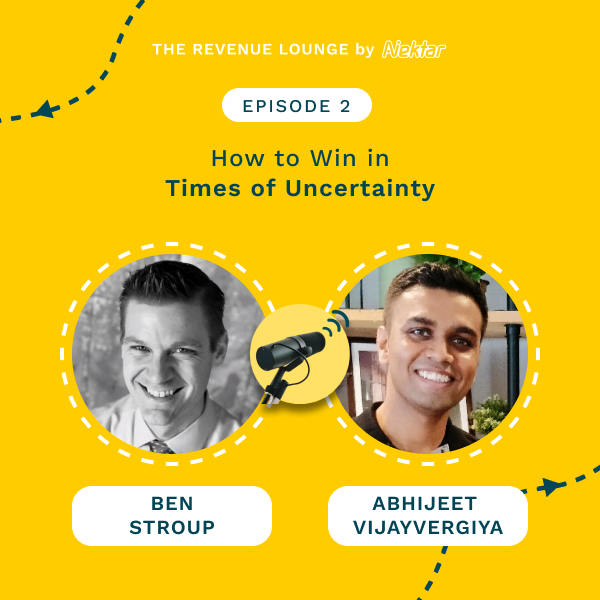
Ep #2: How to Win in Times of Uncertainty
Listen Now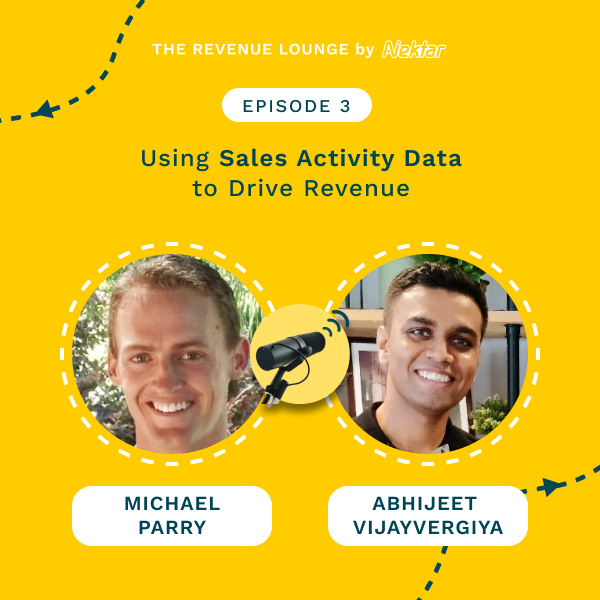
Ep #3: Using Activity Data to Drive Sales Productivity
Listen Now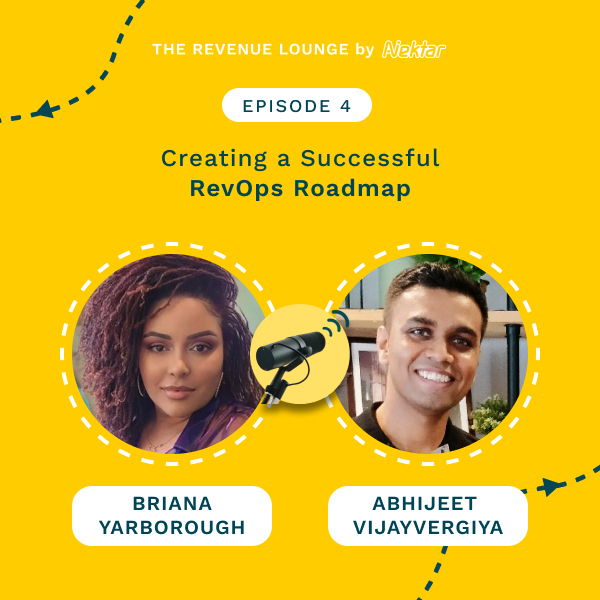
Ep #4: Creating a Successful RevOps Roadmap
Listen Now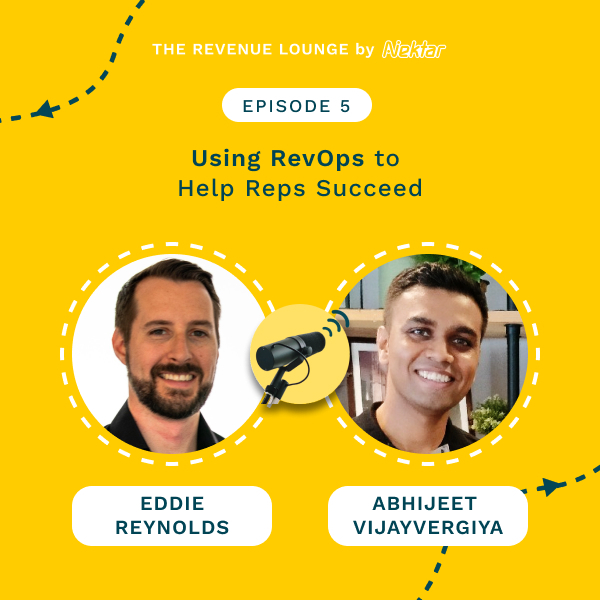
Ep #5: Using RevOps to Help Reps Succeed
Listen Now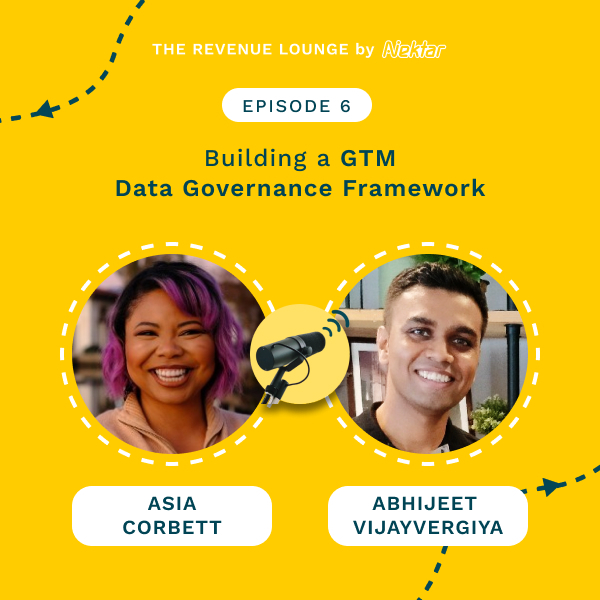
Ep #6: Building a GTM Data Governance Framework
Listen Now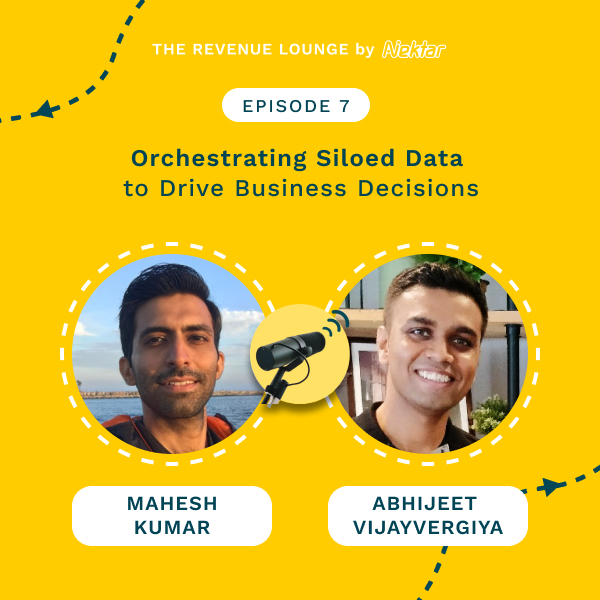
Ep #7: Orchestrating Siloed Data to Drive Business Decisions
Listen Now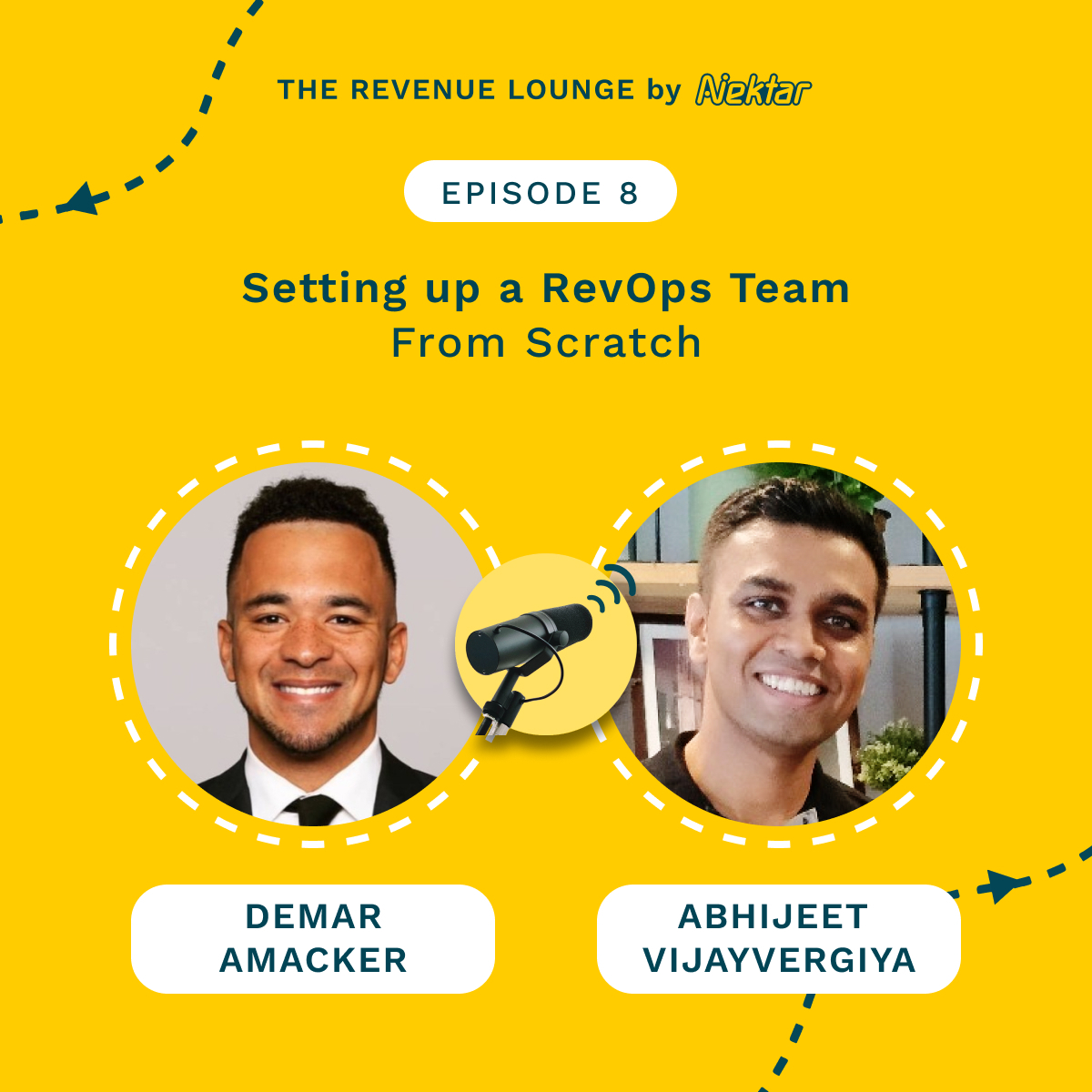
Ep #8: Setting Up a RevOps Team From Scratch
Listen Now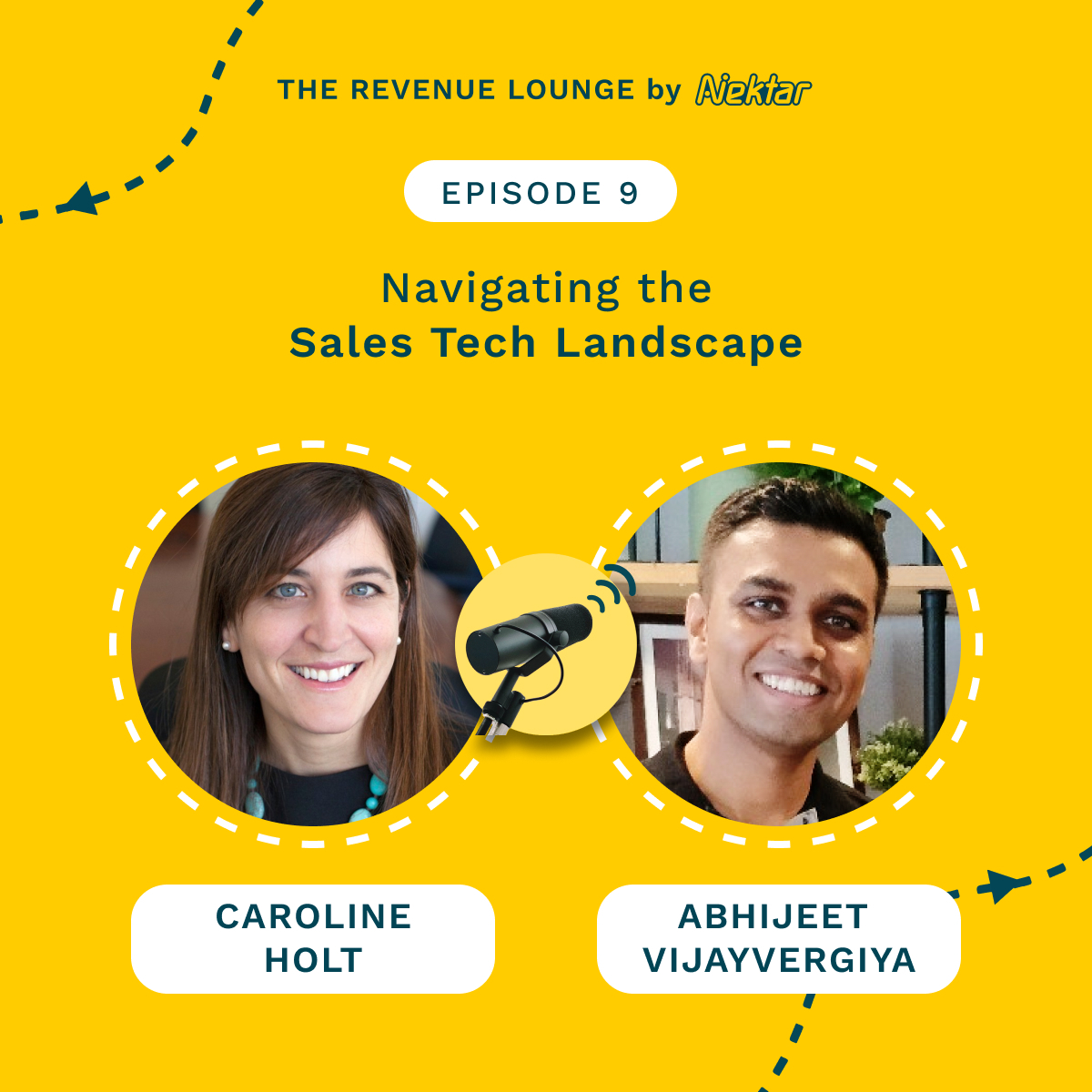
Ep #9: Navigating the Sales Tech Landscape
Listen Now